Content
Russian gardeners learned about the strawberries of the Kupchikha variety not so long ago, but they have already become popular. This is a product of Russian breeders. Kokinsky strongpoint VSTISP. The author of the hybrid variety is the scientist S. D. Aitjanova. The merchant's wife has absorbed the best indicators of her "parents", for some she even surpassed them.
What a beauty:
Kupchikha's strawberries have practically no varietal flaws. It is partly similar to strawberries, partly to wild strawberries. Many gardeners who first purchased or dream of purchasing strawberry seedlings are interested in the characteristic features of the variety itself, the rules for growing earthworms. Let's talk about this now.
Description of the variety
For crossing, Russian breeders took European nutmeg strawberries and large-fruited garden strawberries. The Merchant's strawberry, judging by the description of the variety, photos and reviews of gardeners, fully corresponds to the qualities declared by the breeders.
Let's take a closer look at this question:
- The unpretentious and productive dwarf has a powerful and tall bush. The leaves are wide, trifoliate, juicy green, grow up to 25 cm.
- The merchant's wife throws out over 15 peduncles, each of which has about 10 white flowers with bright yellow centers. When the Merchant's strawberry blooms, the leaves, as gardeners note in the reviews, and judging by the photo below, are practically invisible. The flower stalks of the earthworm are strong, thick, capable of withstanding a rich harvest of berries.
- The berries are large, up to 6 cm long, weighing 20-25 grams. Among them there are also champions up to 35 grams. Kupchikha's strawberries are oblong, ruby-burgundy in color with a purple tint. The first berries on the peduncle are the largest, the rest are slightly smaller. It is interesting, but true: in the Merchant's hybrid, the berries do not fall off themselves, but it is easy to remove the fruits without sepals. The shape of the berries is unusual, which attracts gardeners: there are fruits with three or two horns, as well as oblong. Look at the photo, isn't it a miracle !?
- The taste of the fruit has absorbed the properties of the parents - nutmeg with a hint of wild strawberry. There is no acid in the berries of the Kupchikha variety, they are very sweet.
Characteristics of the variety
Consider the characteristic features of the variety, its differences from other varieties:
- Strawberry Kupchikha belongs to varieties of medium ripening. The first largest berries can be picked in mid-June, when flower stalks begin to be ejected in other beds with ordinary strawberries.
- The variety of the dugout Kupchikha is fruitful. One plant gives 300-400 grams of delicious berries with an indescribable aroma. Weather conditions have almost no effect on yield. If you plant strawberries of the Kupchikha variety in large flowerpots or grow them in a greenhouse, you can collect even more fragrant, sweet fruits.
Fruit set for strawberries Kupchikha is 100%. You can be convinced of the yield of the Zemplunika variety by watching the video: - The merchant's education is average, you can always get a sufficient amount of planting material. Seed breeding of the Kupchikha earthworm, since it is a hybrid, is not recommended. Varietal properties are rarely preserved.
- Judging by the characteristics and reviews of gardeners, the plant is winter-hardy, calmly, practically without losses, tolerates a temperature of -24 degrees under a small shelter. When grown in the zone of risky farming, it will be necessary to cover the Kupchikha strawberries thoroughly. Many gardeners write in reviews that they have to insure themselves, plant some of the outlets in pots and grow at home until spring.
- A high resistance to strawberry diseases is laid in the genes of the earthworm, it is practically not affected by powdery mildew and gray rot, which also makes the variety popular.
- The merchant's wife belongs to varieties with a universal purpose. Berries are good in compotes, jams, preserves. You can freeze. Just imagine what kind of aroma will spread through the apartment when you take the berries out of the cell!
- The variety especially attracts gardeners who grow Kupchikha strawberries for sale. Dense and juicy berries can be transported over long distances. They do not wrinkle and do not leak juice.
- The agrotechnology of growing and caring for the Merchant is simple. In addition, it does not require, unlike many varieties of garden strawberries, frequent transplantation: in one place it can bear fruit for up to five years.
Ordinary garden strawberries can serve as a pollinator.
Often, gardeners complain that they cannot ennoble some part of the garden due to the exuberant growth of perennial weeds... The question can be easily resolved if you plant the bushes of the landowner Merchant and do not remove the mustache during the season. Of course, the yield will decrease slightly. But groundcover strawberries will help control weeds by covering the entire area with rooted rosettes.
Zemlunika is a cover plant:
Landing features
The hybrid strawberry variety Kupchikha, like all other relatives, is demanding when planting in fertile soil. Before digging, the garden must be filled with humus or compost (up to 5-6 kg), add ammonium nitrate (up to 20 g), superphosphate (about 20 g) and charcoal (1 glass). This is the norm for one square meter. Instead of mineral fertilizers, you can use nitrophoska or nitroammophoska, adding 65 grams each.
As already noted in the description and characteristics, it is undesirable to propagate the Merchant's strawberry variety by seeds due to the negligible preservation of maternal qualities. Better to use a vegetative way: root a mustache or divide a bush.
When planting strawberries Kupchikha, if the seedlings do not have a closed root system, you should carefully consider its deepening. The growth point should be at ground level. Below in the photo you can see how to plant strawberries without error. This is necessary primarily for novice gardeners, since experienced gardeners know how to do the job correctly.
When planting dredgers, the distance between the bushes must be taken into account. It should be at least 30 cm, as the plant grows rapidly. In addition, the thickened plantings of the Kupchikha variety will not receive proper nutrition and lighting, which will affect the yield. The row spacing should be within 50 cm.
Care features
The description indicates that it is not difficult to care for Merchant's strawberries. The variety yields well with drip irrigation, the main thing is not to overmoisten the soil. Small drought tolerates steadily, without reducing fruiting.
Strawberries need to be in the sun for several hours, so they can be planted between bushes and trees. He loves loose soil, so from time to time you need to loosen, weed out the weeds, and feed the strawberry plantings.
Good planting material can be obtained from rooted outlets. The mustache must be removed from fruiting bushes so as not to deplete the bushes. Replace the plantings of the Kupchikha variety after 4 years.
As you can see, planting and caring for a dugout is not a big deal, just like preparing for winter. Leaves and shoots are cut off on the bushes, covered with straw and non-woven material.
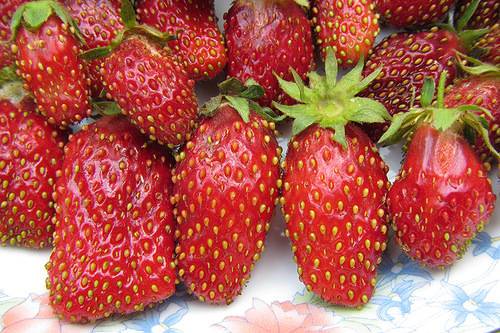
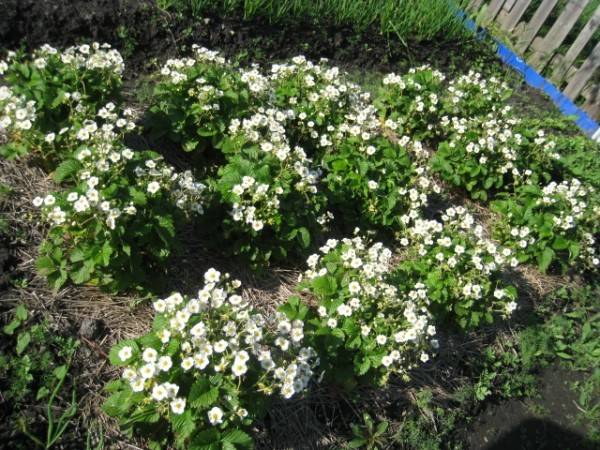
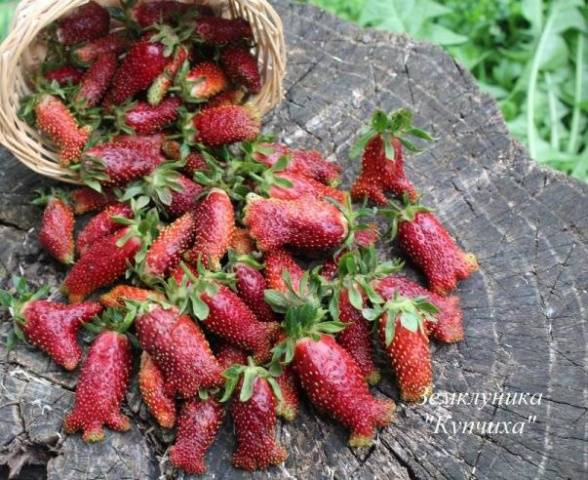

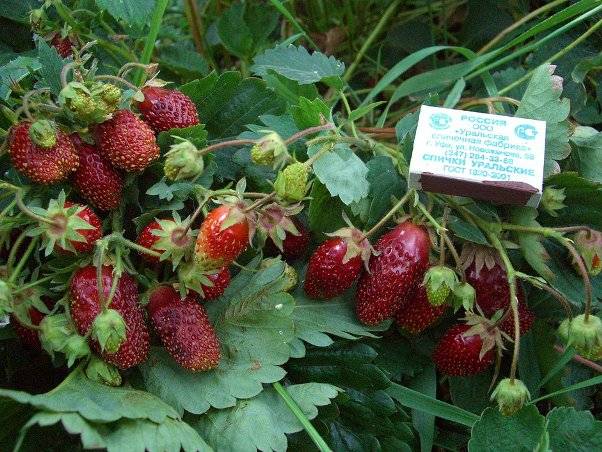
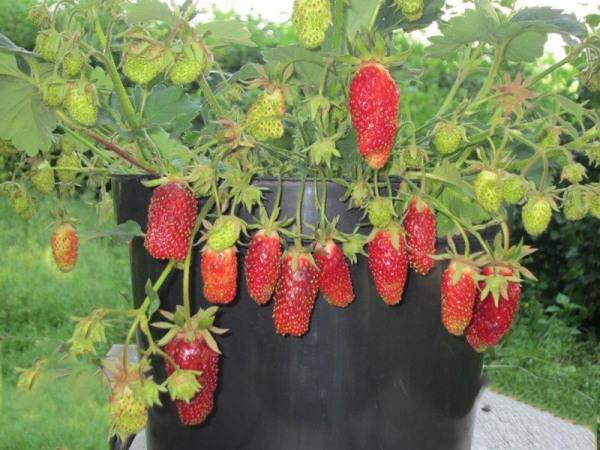
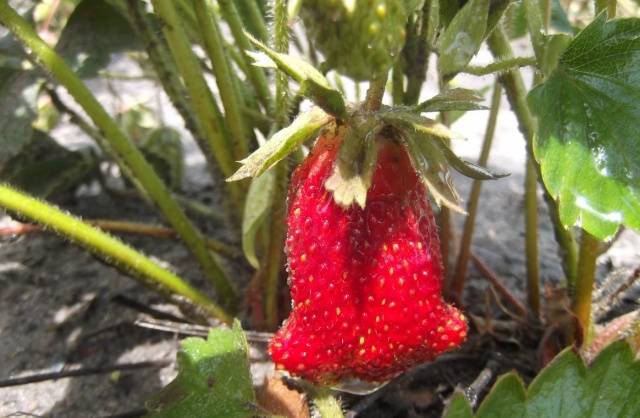
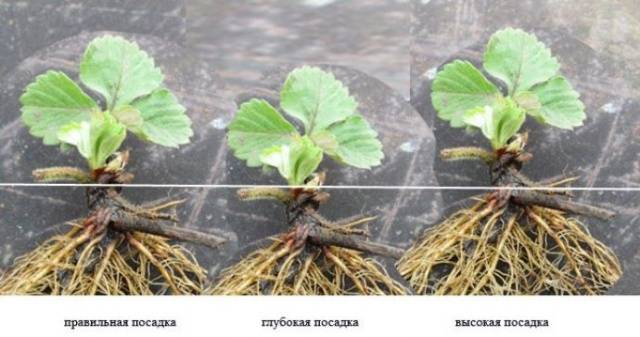
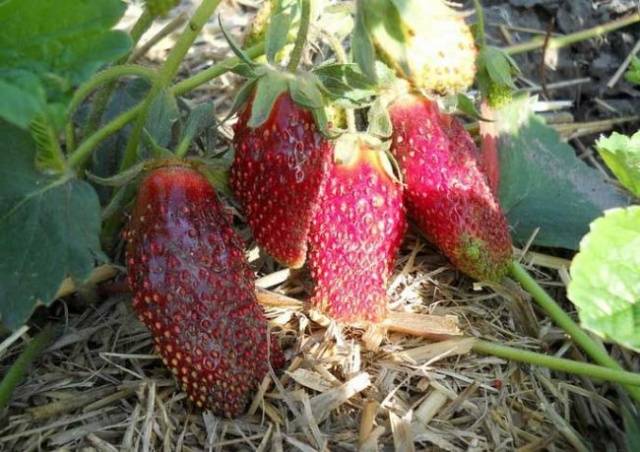
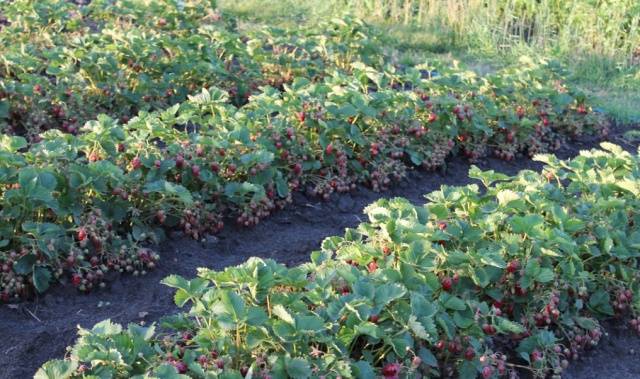
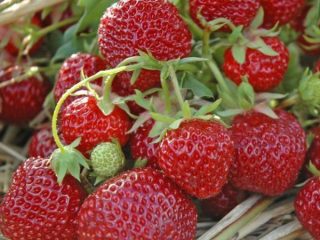


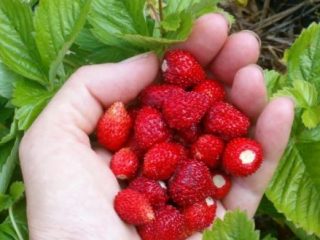
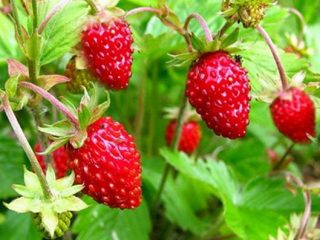

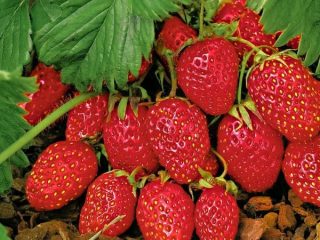
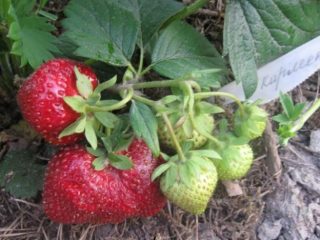
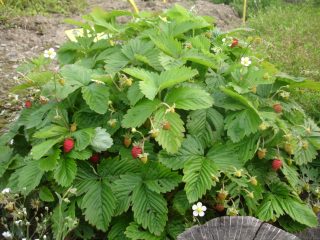
Good day! My strawberries began to wither, with flowers and berries, including the Kupchikha variety, although they write everywhere that this variety is practically not affected by diseases. I read that it is a fungal disease. The bushes bloomed very profusely, almost no leaves were visible, and then the peduncles began to brown and dry out. I tried to cast with preparations containing beneficial bacteria, it seemed to help for a while, but I had to dig up and throw out some bushes, it did not help. Tell me, please, someone else faced such a situation, will all the bushes die and nothing can be done to help? Thank!
Good day!
It is advisable to see a photo of drying peduncles. It is possible that the strawberry bushes were attacked by such a pest as the raspberry-strawberry weevil. He pierces the stalks of the peduncles and drinks the juice. Therefore, the inflorescences begin to wither almost from the root, dry out and turn brown.
At the moment, it is undesirable to process strawberries during the flowering and fruiting period. As a last resort, you can use biological products such as Fitoverm or Akarin. Or use folk recipes:
• 40 grams of laundry soap (grate) and dilute 0.5 kg of ash in 10 liters of boiling water. Insist for at least 12 hours, spray the bushes.
• Pour tobacco dust around the strawberry bushes or make an infusion of it and spray the beds.
• Pour a bunch of wormwood with 5 liters of water and boil for 10 minutes. Strain. Add 40-50 grams of laundry soap (grated) to the infusion, stir. Dilute to 10 liters with water. Freeze and process strawberry bushes.
• Garlic infusion. Mix 100 grams of chopped garlic with 10 liters of water, leave for 24 hours. Spray the beds.
There are a lot of folk remedies for pests. You can choose the one that suits you.
And don't forget about preventive measures. From the strawberry-raspberry weevil, strawberries are processed in early spring, before flowering. In the fall, both strawberry bushes and soil are treated in order to destroy all pests.
Help with advice My merchant's strawberry wintered very well, but such bushes are large and there are few dry green foliage, what should I do to cut it or leave it like that
Good day!
Strawberries, and not only the Kupchikha variety, but all varieties, almost always go into winter with green leaves. And in the spring, after the snow melts, green bushes are already decorating the beds. However, do not flatter yourself. Leaves that have survived the winter, they will not bring much benefit to strawberry bushes.But they can cause infection and spread of fungal and infectious diseases.
In addition, after a few days, the first leaves will appear on the bushes, and the old foliage will gradually die off. Therefore, it is advisable to cut and feed the strawberry bushes, and clean the beds.
Hello ! whoever encountered such a problem on a merchant's wife, after wintering, the bushes are tightly twisted, bloom poorly, flower stalks are short or they are not at all. Write down how to fight and what it is. thank
Try pouring 40 ml of ammonia into a bucket of water in the spring, maybe someone is eating up the roots